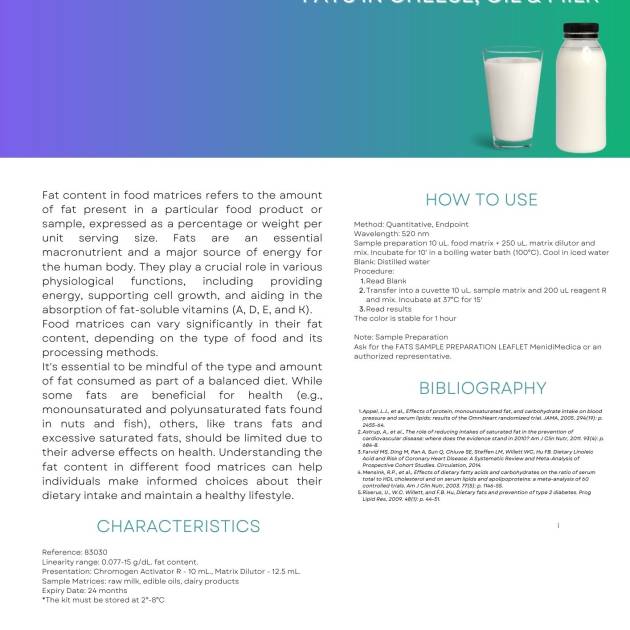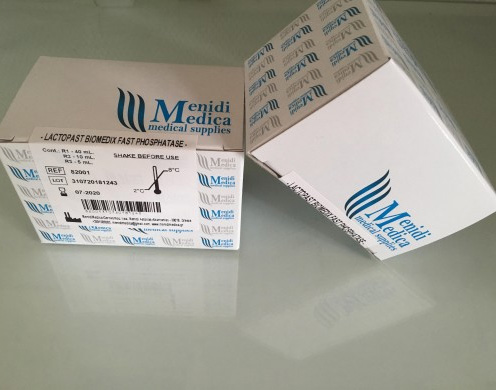Description
PRINCIPLE
Sodium is determined enzymatically via sodium dependent β–galactosidase activity with ONPG as substrate. The absorbance at 405 nm of the product O-nitrophenyl is
proportional to the sodium concentration.
CONTENTS
MM-1050
R1: 100 mL., R2: 50 mL, Calibrator: 1 mL. (150 mmol/ l)
R1 Buffer / Enzymes,
Tris buffer, Cryptand, β-galactosidase
R2 Buffer / Substrate
Tris buffer
O-nitrophenyl galactoside
REAGENT PREPARATION AND STABILITY
R1. Buffer/Enzymes – Ready to use
R2.Diluent/Substrate – Ready to use
All the reagents of the kit are stable up to the end of the indicated month and year of expiry. Store tightly closed at 2-8ºC. Do not use reagents over the expiration date.
SPECIMEN
Serum, plasma treated with lithium heparinate.
MATERIAL REQUIRED BUT NOT PROVIDED –
Spectrophotometer or colorimeter measuring at 405 nm. Matched cuvettes 1.0 cm light path.
TEST PROCEDURE
1. Assay conditions:
Wavelength: 405nm
Cuvette: 1 cm light path
Constant temperature: 37ºC / 15-25ºC
2. Adjust the instrument to zero with distilled water.
3. Pipette into a cuvette:
(For cal.)
R1: 1000 uL. + R2: 500 uL. + cal.: 25 uL.
(For sample)
R1: 1000 uL. + R2: 500 uL. + sample: 25 uL.
4. Mix and read the absorbance after 120 s (A1) and 360 s (A2).
5. Calculate: ∆A= A2 – A1.
QUALITY CONTROL
Control sera are recommended to monitor the performance of the procedure. If control values are found outside the defined range, check the instrument, reagents and calibrator for problems. Serum controls are recommended for internal quality control. Each laboratory should establish its own Quality Control scheme and corrective actions.
REFERENCE VALUES
136 – 146 mmol/l (313 – 336 mg/dl) (These values are for orientation purpose). It is suggested that each laboratory establish its own reference range.
CLINICAL SIGNIFICANCE
Sodium measurements are used in the diagnosis and treatment of aldosteronism, diabetes insipidus, adrenal hyper-tension, Addison’s disease, dehydration, inappropriate antidiuretic hormone secretion, or other diseases involving electrolyte imbalance.
REAGENT PERFORMANCE
– Linearity: The method is linear between sodium concentrations of 80.0 and 180.0 mmol/L
– Precision:
Media (mmol/L), Intra series (n=20) 128.94, 155.84/Inter series (n=20) 128.94, 155.84
SD (mmol/L), Intra series (n=20) 1.57, 1.72/Inter series (n=20) 2.01, 2.56
CV (%), Intra series (n=20) 1.20, 1.10/Inter series (n=20) 1.56, 1.65
– Sensitivity: The minimum detectable concentration of sodium with an acceptable level of precision was determined as 80.0 mmol/l.
– Accuracy: Results obtained using MenidiMedica reagents (y) did not show systematic differences when compared with other commercial reagent (x).
The results obtained using 53 samples spanning the range 86,2 to 174.7 mmol/L were the following:
Correlation coefficient (r): 0.98.
Regression equation: y= 1.05x – 2.23
The results of the performance characteristics depend on the analyzer used.
NOTES
1. In order to avoid contamination it is recommended to use disposable material.
2. MenidiMedica has instruction sheets for several automatic analyzers. Instructions for many of them are available on request.







